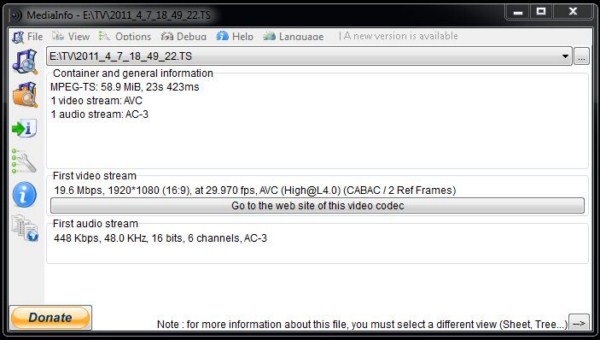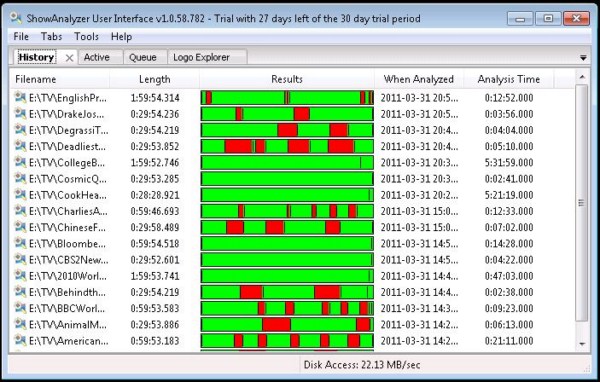Hauppauge Colossus: HD PVR with HDMI Support
by Andrew Van Til on April 14, 2011 5:40 PM EST- Posted in
- HTPC
- Home Theater
- Hauppauge
Testing and Evaluation
With an original HD PVR and Ceton InfiniTV 4 Digital Cable Tuner (DCT) on hand, it provided us with the opportunity to record the same content using MediaInfo and perform visual inspections to document differences in quality. For the results above, the Colossus and HD PVR were configured in-line using the YPbPr/TOSLINK pass-through from the STB. They were set to use the highest recording profile in SageTV, with SageDCT used to capture the raw TS stream from the InfiniTV 4 as a reference point. The settings used by the various devices are summarized in the following table.
| Device Recording Profile Summary | |||
| Video Resolution | Colossus | HD PVR | SageDCT (RAW) |
| 480i | 3985 Kbps 720x480@29.97 AVC (Main@L3.2) (CABAC/2 Ref Frames) | 4695 Kbps 720x480@29.97 AVC (Main@L3.1) (CABAC/4 Ref Frames) | 2948 Kbps 528x480@29.97 MPEG2 (Main@Main) |
| 720p | 7924 Kbps 1280x720p@59.94 AVC (High@L4.0) (CABAC/2 Ref Frames) | 11.8 Mbps 1280x720@59.94 AVC (Main@4.0) (CABAC/4 Ref Frames) | 10.5 Mbps 1280x720@59.94 MPEG2 (Main@High) |
| 1080i | 12.7Mbps 1920x1080i@29.97 AVC (High@L4.0) (CABAC/2 Ref Frames) | 11.7Mbps 1920x1080i@29.97 AVC (High@L4.0) (CABAC/4 Ref Frames) | 16.5 Mbps 1920x1080@29.97 MPEG2 (Main@High) |
There are differences in the bitrate and AVC profiles used by the two Hauppauge devices; the Colossus uses a higher rate for 1080i and the HD PVR uses higher bitrates for 720p and 480i. The InfiniTV 4 was a third set of values. With three points of reference and digital source content, there is little noticeable difference between the captured files in real terms. (If you’re interested in seeing clips of the videos, let us know and we’ll see about including download links.
Alongside the comparative testing, the Colossus was also evaluated for the overall quality and “watchability” of recordings captured at native resolution from the STB. We recorded sixty files with a 33% distribution per resolution at random intervals and channels, and then sampled at five to ten points in each file for issues related to audio and video. We looked for A/V synchronization problems, stutter, and dropouts, and the final result is an 8.33% fail rate. Most of the “fail” issues only occurred in specific locations in the files, and while annoying they were not severe enough to abandon playback. However, there were also entire recordings with no audio or significant enough issues with audio drops or video playback that continued viewing was very unpleasant or impossible.

Before moving on it is interesting to note that the maximum bitrate available in ShowBiz and via the encoder’s property page (shown below) is quite a bit higher (~20Mbps) than what is used by SageTV when selecting the best rate (~14 Mbps). It is unlikely that the value of encoding at this high a level would result in a great enough pay off to justify the increased file size given the bitrate of most TV content, but it is good to know that it is possible if the content warrants it.
Additional Testing
I love it when my interests in the HTPC space overlap, so having observed the difference in bitrate capabilities and issues with file capture it provided an easy excuse to start writing code against the Colossus and figure out how to drive the device. For anyone who has done any playing with DirectShow, the following screenshot of the capture graph in GraphStudio should be very familiar. It demonstrates the four components necessary to enable file capture from the device with the property pages for the “Capture” and “Encoder” filters (which are what ShowBiz exposes through its GUI) displayed. The file sink—the component at the end that writes the TS packets to disk as they are output from the encoder (in this case a slightly customized version of the “Dump” sample included in the Windows SDK)—is the only filter not provided by the drivers.

Using that as a starting point I wrote a simple application to prototype input selection (it supports component + S/PDIF or HDMI) and filter configuration. Using standard DirectShow interfaces, I was able to reproduce both the capture issues and the inconsistent bitrate values observed with ShowBiz and SageTV, where after setting the device to the maximum bitrate (~20Mbps) through the encoder interface it actually uses ~14Mbps. I have asked Hauppauge to provide documentation for programming against the device in case there is a different, non-obvious, mechanism for configuring the card, but they did not provide it in time for this review. For anyone interested in looking at the source code for the application it is available here.

Anyone who made the jump to the original HD PVR when it was released will remember that the commercial scanning story was a bit troubled. Fortunately, the work that was done to support the AVC TS files created with it carries over to those generated using the Colossus. Applications like ShowAnalyzer are able to scan the files and detect commercials in them.










60 Comments
View All Comments
bobbozzo - Saturday, April 16, 2011 - link
I think he wants to capture and stream to another PC live.e.g. the client PC has no tuner, and uses a 'TV server' to watch live content.
jnmfox - Thursday, April 14, 2011 - link
I see you have Sage with the Diamond UI installed.Is anandtech.com going to do a review of SageTV?
I got SageTV set-up a couple of months ago and love it. Sage is a great HTPC option, hopefully more people can be made aware of it. The HD-300 extenders are a great option to get content to you HDTV; small, low-power, customizable, high WAF.
babgvant - Thursday, April 14, 2011 - link
I'm a big fan of the Diamond UI. SageTV V7 is a solid platform, but the stock UI leaves a lot on the table; the Diamond team has done an excellent job of making it second to none in this space.Bob-o - Thursday, April 14, 2011 - link
I'm running Kubuntu linux on a machine in my home office. Is SageTV my best option for recording TV on this platform? I know about Myth but have never tried it.My HTPC in the living room is a modest machine running XBMC, mounting a disk from the office machine using NFS. I'd like to leave that as-is.
Thanks!
babgvant - Friday, April 15, 2011 - link
There is a Linux version of the SageTV server, so it should work but I've never tried it.queequeg99 - Friday, April 15, 2011 - link
Sage keeps the linux version as up to date as the Windows version. However, it is clearly aimed at OEMs so support can lag a bit (i.e. you better feel reasonably comfortable messing around in linux).tno - Thursday, April 14, 2011 - link
That said, it reminds me, bittersweetly, of all the time I spent configuring my HTPC when I had it fully loaded with tuners, drives and some complicated quiet cooling. When it occurred to me that I spent more time fiddling with it than the household cumulatively spent watching TV I needed to simplify. Now we're down to a quiet, low-power, SSD-only uber streamer. Only thing that ever breaks now? Netflix.eselig - Thursday, April 14, 2011 - link
Before anyone seriously considers this card, please be aware that Hauppauge has a proven history of not supporting their equipment. Essentially, this card will work for Windows 7, but when windows 8 comes out, they'll put out the drivers for whatever their new card is, but nothing legacy. After getting burned by them twice this way, I've learned my lesson and will never buy a Hauppauge card again.Anthony Toste - Friday, April 15, 2011 - link
That wrongAre you cry about lack 64bit drivers for old 250/350 well that not possable you see the can't fix after all it frist made in 2001/2 by iCompression know as iTVC15 which I think is base on 16/32bit hardware so there for Windows 64bit OS will not work
Oh think Hauppauge has a proven history of not supporting their equipment boy you should look at all other capture device out there which are far woste then Hauppauge.
silverblue - Friday, April 15, 2011 - link
AverMedia's support isn't the best either. I got a Nicam Stereo TV capture card in 2004 which was then not supported in Vista. Perhaps I should've spent more, however I was eager not to get something priced far more that offered basically the same (i.e. Hauppauge).My AverTV Studio203 is sat in my PC doing nothing as there's no drivers for it, nor was there a new version released after I bought it... shame. Not a stunning card, all things considered, but decent capture cards aren't exactly two a penny, and spending money unnecessarily isn't my cup of tea.